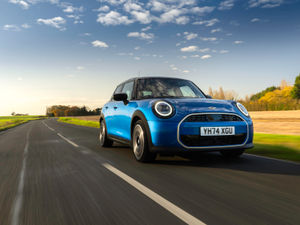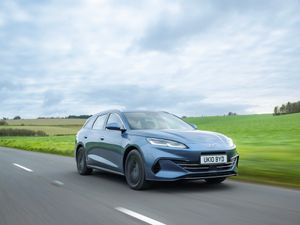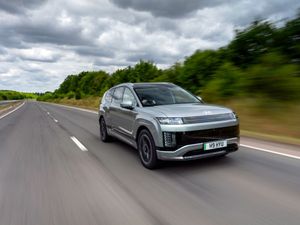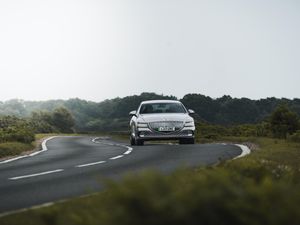New Subaru Outback is the best in niche market
It isn't that often that when you buy a car, you get a driving companion to go with it . . .
But Subaru's latest flagship comes with an extra pair of 'eyes' (and feet) which are there to keep you and your car safer on the roads. Or since this is the new Outback, off the roads, too.
It's showcases the company's new 'Eyesight' system which uses a stereo camera to recognise hazards, warn and the driver, and then cut the throttle, brake and/or steer around the danger if needs be.
The original Outback was launched 20 years ago as a beefed up version of Subaru's all-wheel drive Legacy estate car which significantly improved off-road, all weather abilities and became much beloved of country vets, among others.
It's something of a niche market but one which has spawned a host of imitators as car makers target the active leisure as well as the workhorse sector..
The new model comes with a choice of 2.5 litre petrol or 2.0 litre diesel engines, the option of automatic transmission and prices from £28,995 to £32,995.
Even in an ever growing and more competitive niche in the market, the Outback manages to drive its own road. It's cheaper than many alternative SUVS and 'premium' rivals, but with more genuine go-anywhere ability than cheaper rivals adapted from road-going estates with the addition of part-time four wheel drive.
But while this new model has gone upmarket, with a greatly improved interior and lots of extra equipment, including the Eyesight system, Subaru has also made it more fuel efficient to reduce fuel and tax costs.
The design is sleeker than its predecessor, although it's looks are more rugged than sporty as befits its role. The 200mm ground clearance and big plastic bumpers front and rear are clues (and necessities) for its off-road capabilities too.
It's also longer and wider, with room for five passengers in comfort and a useful 559 litres of cargo space with the rear seats up.
Big tyres on 18 inch rims and the new suspension ensure a particularly comfortable ride for a dual role vehicle but the Outback retains its dynamic abilities on the road. The steering is sharp and accurate, and as well as the permanent four wheel drive system it now has an active torque vectoring system. In simple terms, it applies a portion of the cars braking power to the inside wheels in a corner, keeping the car on a neutral line and reducing any under or oversteer.
It also plays its part in the overall active safety set up by helping the driver if you have to swerve suddenly to avoid a collision.
These are some of the technologies which make the Outback feel light and nimble even on bendy B-roads: you are never conscious of its obvious size and weight as you are with a more traditionally styled SUV.
But it's the Eyesight system of which Subaru is particularly proud. It's only available on the Lineatronic versions and uses a stereo camera mounted behind the rear view mirror. It scans the road ahead and can tell the difference between solid objects, pedestrians and cyclists, and even spot the brake lights of a car in front coming on.
I was able to test its effectiveness on an old airfield. You might be surprised how hard it is to overcome your survival instincts and deliberately drive at a solid object but I shouldn't have worried. At 30mph, the Outback gave an audible and visual warning and if you still don't react the car applies its braking power automatically, bringing you to a stop. The system also manages the throttle: you can rev all you like but the car won't move if you're close to a hazard and, for example, select forward instead of reverse, or hit the throttle by mistake.
Subaru says it works at up to 31mph and at higher speeds it will help to lessen the effects of an impact. Or, with the aid of the torque vectoring system and ABS, you could swerve around the hazard. The combination of systems no doubt played a major part in EuroNCAP's decision to award the Outback a maximum five stars for safety.
I didn't get a chance to go off-road in the new car, but I well remember tackling gravel forest tracks in the previous model, reaching speeds of 60mph with no slip and slide.
But its performance should be better, with the addition of the new torque vectoring system and the X-Mode button which reconfigures the various systems for rugged terrain, including a hill descent control to help you crawl safely down steep, slippery slopes.
Both petrol and diesel engines have been heavily modified compared to the last Outback, with fuel efficiency the target. And there's even a front grille which opens and closes automatically for a quicker warm-up with improved air flow on the open road.
The 2.5 litre petrol engine comes with the LIneatronic system (there's no manual option) which is a CVT automatic system with seven preset ratios if you want to change gears manually. Compared to its predecessor, power is up from 167 to 175PS, but fuel consumption is improved to 40.7mpg and CO2 emissions are down several tax bands from 175 to 161g/km (VED band G).
The 2.0 litre diesel comes with the option of auto or six-speed manual transmissions. It has 148bhp and a hefty 350NM of torque and is both a little quicker and more economical than its petrol sibling.
Not surprisingly it's the diesel (the world's only boxer diesel engine) which is expected to account for the majority of sales in the UK.
While Subaru has good reasons for believing its Outback is best of the bunch when it comes to off-road ability, there's a lot of work gone into giving the interior a much more upmarket, premium feel to win over buyers from the big-name brands.
The most striking thing is the new seven-inch touch screen information and control panel, as well as voice control: you can now tell the satnav where you want to go, without keying in an address.
This new feature also controls the trip computer, audio, communications and climate control, with remote controls on the steering wheel, too.
The whole cabin has a higher grade feel, with improved plastics, tactile leather controls and chrome trim highlights. With new aerodynamic and soundproofing measures, the Outback feels rather more refined, too.
In some ways, that sums up the new Outback: rugged yet refined. It is a true go (almost) anywhere vehicle which will outperform even some dedicated SUVs when the going or the weather gets rough yet it looks and feels like a premium estate.
It's price isn't cheap for most of us, but it is highly competitive amongst a raft of rival vehicles and its running costs have been reduced, making it look an even better bet in fuel economy and tax terms than many luxury SUVs or even its predecessor.
Subaru's ambitions for Outback sales are relatively modest, but even in a niche market it's best to be the best.
By John Griffiths





